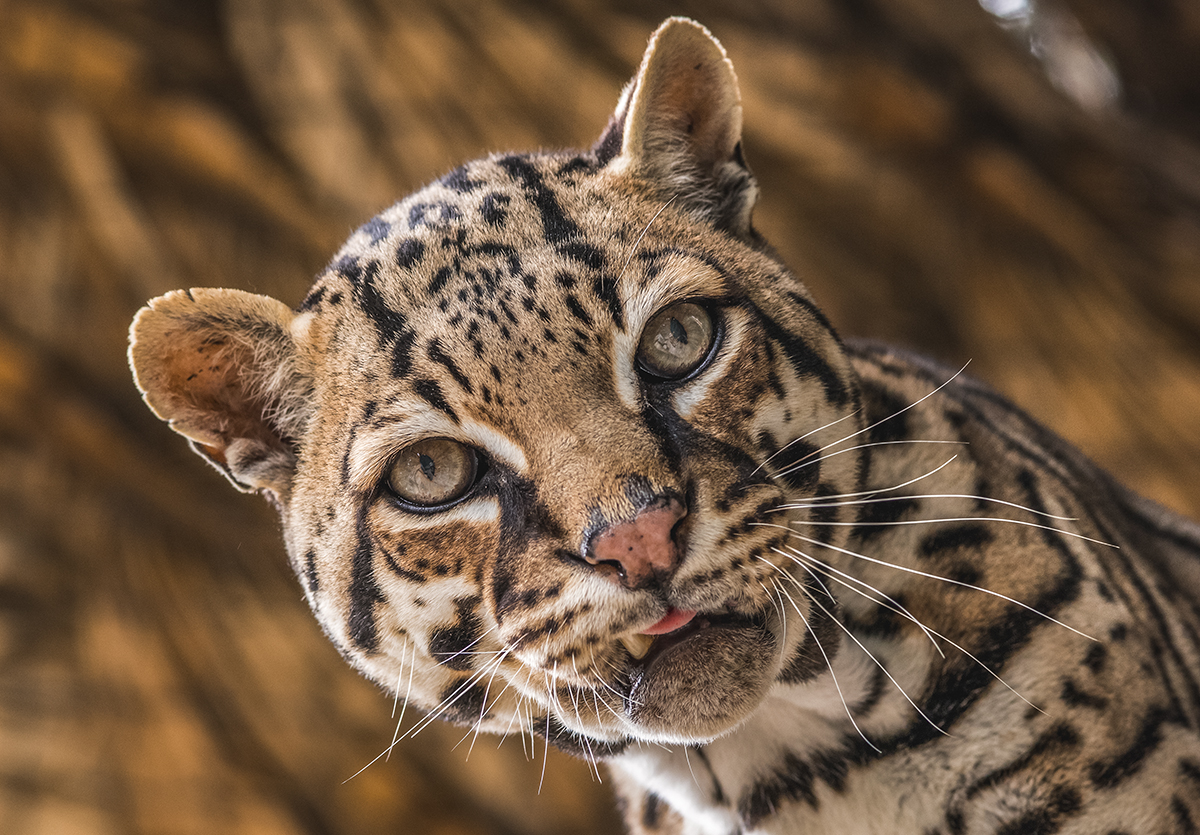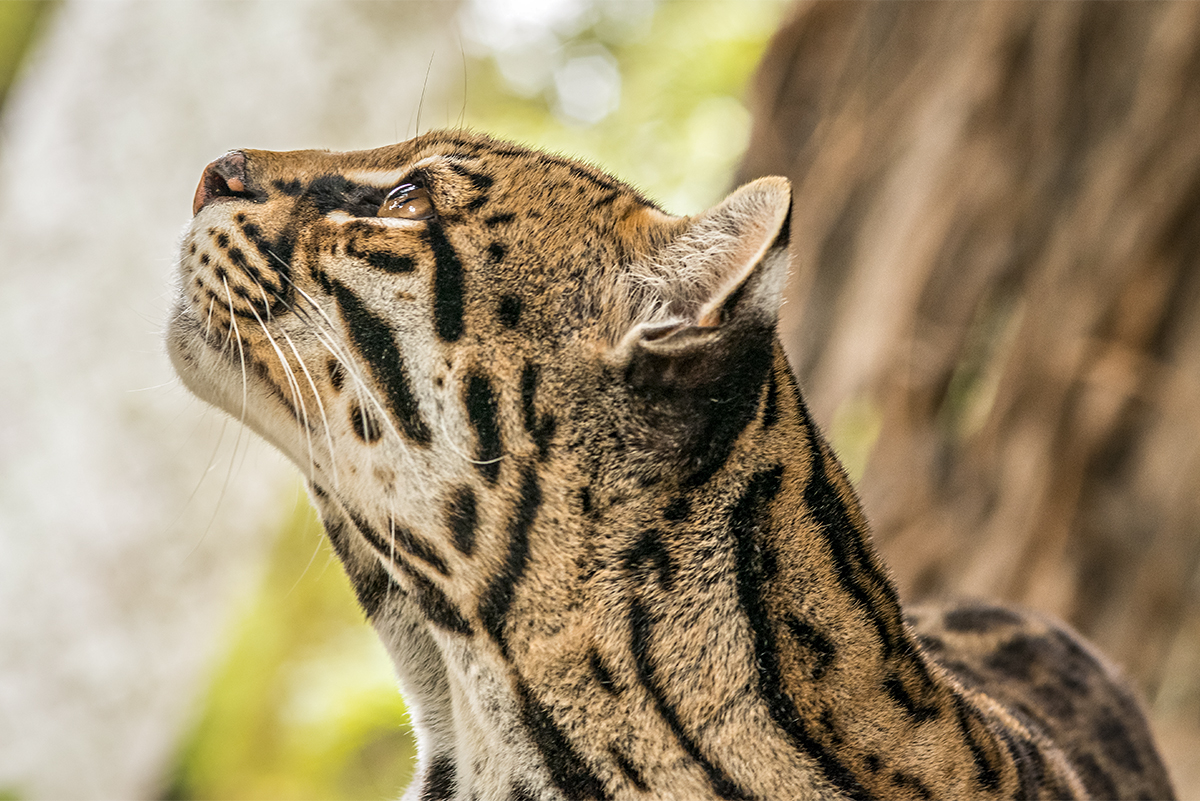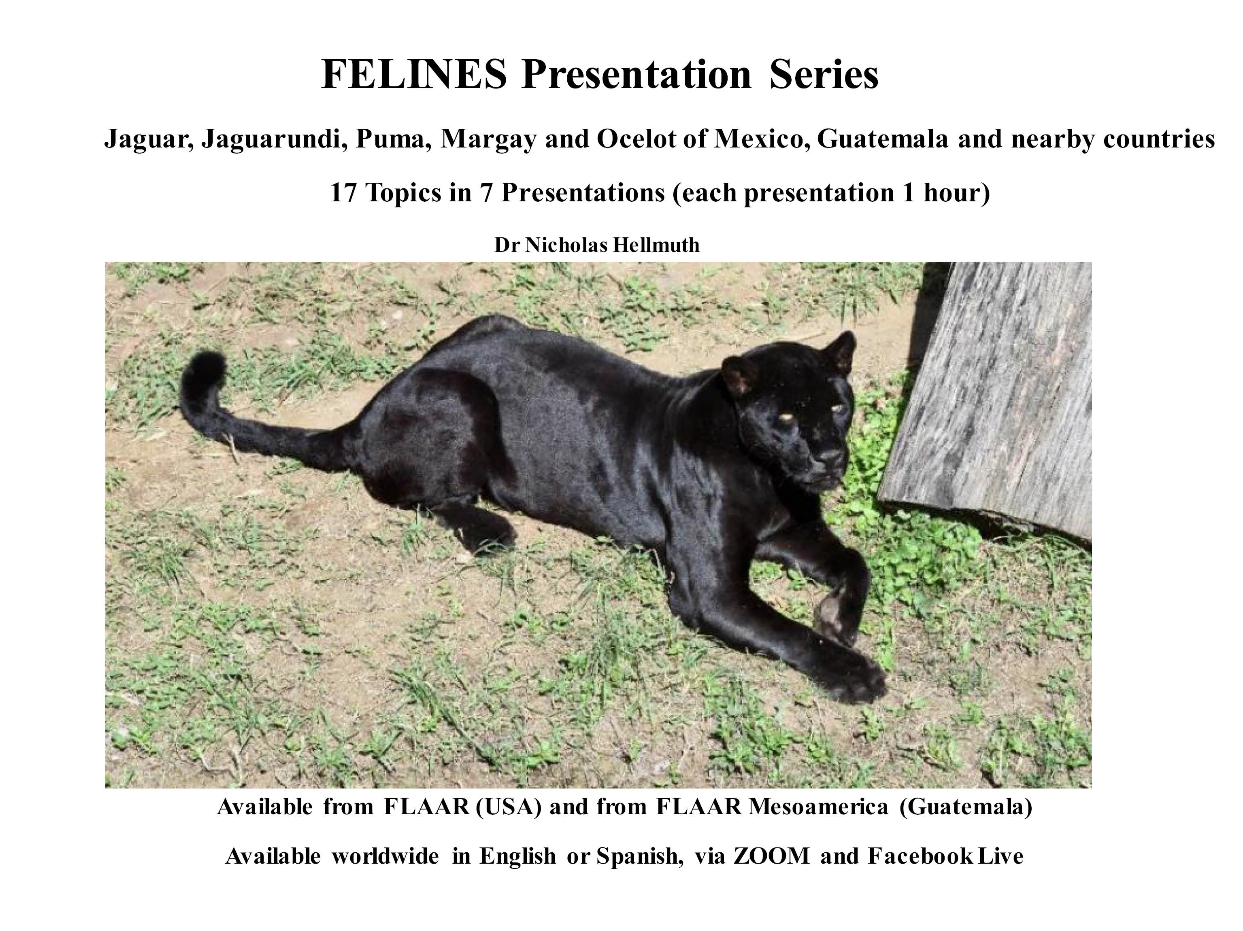Margay, Leopardus wiedii, Schinz, 1821
The margay resembles a small, long-tailed ocelot, but it differs by several traits: shorter head and body length of 545 mm, longer tail (385 mm) and very large eyes. Margays also have a smaller size and weaker structure of the skull (De Oliveira, 1998). Also, margays differ from oncillas (L. tigrinus) by the hair on the nape directed backwards in the latter species. This feline is adapted to arboreal life, that is why their paws are very flexible. The very large, bulging eyes and paws of margays are also distinctive. Finally, margays differ from other species of Leopardus by having a longer tail and a spot pattern in the pelage not displaying in the usual small solid dots’ characteristic of other species (De Oliveira, 1998).
The coat is soft and full, and upperparts vary from pale buff-grayish to an intensely rich ochreous-tawny and dark brownish-ochreous color, paling toward the lower part of the sides. The usual pattern consists of large solid dots on the mid-back and large and complete rosettes on the sides. The long tail is colored like the body and there are longitudinal lines on the head, nape, and back. Also, males and females are about the same size (De Oliveira, 1998).
For 2015, according to the IUCN List of Threatened Species, Leopardus wiedii was listed as Near threatened. This is because margays populations are declining through much of its range due to human induced conversion of native forest habitats to agriculture, pasture, and infrastructure development, and is predicted to continue over the next 18 years. Although the species shows a large extent of occurrence, its area of occupancy is much smaller (De Oliveira, 2015).
L. wiedii is distributed from Sinaloa and Tamaulipas, Mexico, through Central America and the mountains and lowlands areas of Peru, Ecuador, Bolivia, Colombia, Venezuela, the Guianas, south Paraguay, the southern portion of Brazil, Argentina, and northwestern Uruguay (De Oliveira, 1998).
Margay spots occasionally found in Late Classic Maya ceramics
The feline most often pictured in art of Mesoamerica is the majestic jaguar. Pumas are occasionally pictured but not often. Ocelots, margays and jaguarundis are not well documented in Classic Maya art. But one ocelot or margay is present on one bowl and ocelot and margay pelage patterns (spots and other designs) are pictured occasionally on Late Clasic Maya art.
Short PowerPoint on preview for 17 topics on felines of Mesoamerica: zoology, ethnozoology and iconography. All these topics are divided into 7 different presentations.
These lectures on iconography and zoology of jaguars, pumas, etc. in the art of Maya, Teotihuacan murals, Cacaxtla murals, Aztec, Mixtec and Maya codices, and felines on Maya murals, stelae, ceramics, etc. are available to your university, research institute, zoo, alumni club, social club, family and friends. A contribution to our on-going and recent half-century of field work and library research would be appreciated.
You can select one, two, three or however many different presentation topics you prefer
Presentation can be in-person anywhere in the world, or via ZOOM. In Spanish or in English, or simultaneously translated for your preferred language.
Contact email is on the last page of this PPTx
The feline on the front cover is a black jaguar, found in Guatemala, Mexico and surrounding countries. This is not a “black panther” and is not a leopard: it’s a jaguar of Mesoamerica.
White jaguars and rare gray jaguars also exist (as you will see in this new PowerPoint lecture by Nicholas Hellmuth and his team at FLAAR).
- 1998
- Mammalian Species. Leopardus wiedii. American Society of Mammologist, No. 579. 6 pages.
- 2015
- Leopardus wiedii, Margay. The IUCN Red List of Threatened Species. 14 pages.
Available Online:
http://dx.doi.org/10.2305/IUCN.UK.2015-4.RLTS.T11511A50654216.en
PDF, Articles, Books on Leopardus wiedii
- 2005
- Serologic survey of domestic felids in the Petén region of Guatemala. Journal of Zoo and Wildlife Medicine, Vol. 36, No. 1. Pages 121-123. https://doi.org/10.1638/03-059
Available Online:
https://bioone.org/journals/journal-of-zoo-and-wildlife-medicine/
volume-36/issue-1/03-059/SEROLOGIC-SURVEY-OF-DOMESTIC-
FELIDS-IN-THE-PET%C3%89N-REGION-OF/10.1638/03-059.short
- 2009
- Registro notable de margay (Leopardus wiedii) en el bosque mesófilo de montaña de Morelos, México. Revista Mexicana de Biodiversidad. No. 86. Pages 1110-1112.
Available Online:
www.revista.ib.unam.mx/index.php/bio/article/viewFile/1309/1216
- 2012
- Primer registro del Tigrillo (Leopardus wiedii Schinz 1821) y del gato montés (Lynx rufus, Kerr 1792) en la reserva de la biosfera de Tehuacán-Cuicatlán, Oaxaca, México. Acta Zoológica Mexicana. Vol. 22, No. 1. Pages 135-139.
Available Online:
www.redalyc.org/pdf/575/57555113.pdf
- 2012
- Spatial patterns of the margay (Leopardus wiedii; Felidae, Carnivora) at “El Cielo Biosphere Reserve, Tamaulipas, México. Mammalia. No. 76. Pages 237-244.
Available Online:
http://smallwildcats.com/wp-content/uploads/Carvajal_et_al_2012.pdf
- 2019
- Salud de felinos silvestres en cautiverio- Estudio integral en el Centro de Rescate para la Vida Silvestre La Marina-Costa Rica. Brenesia. Pages 13-20.
Available Online:
www.bvs.sa.cr/articulosexternos/art17.pdf
- 2012
- Dos nuevos registros de margay (Leopardus wiedii) en Oaxaca, Méico, con datos sobre hábitos alimentarios. Cuadernos de Investigación UNED. Vol. 4, No. 1. Pages 33-40.
Available Online:
www.redalyc.org/pdf/5156/515651981005.pdf
- 1998
- Leopardus wiedii. Mammalian Species. No. 579. Pages 1-6.
Available Online:
https://watermark.silverchair.com/579-1.pdf?token=AQECA
Hi208BE49Ooan9kkhW_Ercy7Dm3ZL_9Cf3qfKAc485ysg
AAAa0wggGpBgkqhkiG9w0BBwagggGaMIIBlgIBADCCA
Y8GCSqGSIb3DQEHATAeBglghkgBZQMEAS4wEQQM
Du5VETVQckBd19XhAgEQgIIBYEqhbQOccLO8NXXU2
uizoFG-IYNXccxd302NZhvc44bpbCUQFreWJYxJWWbb
auR0LNIw0tT-mH6zHTSk7pcsoZVzQ9ZzP4nEvbz0SMUH
2ecD721bqxOKw6m-OJPxl910KrGXEY9Q5VPIZPMvr9w
4iwnABZWRZHmhAKAfLpq6V5ZaMgdwutWmAtFdkw9b6
bqiJ6tWo1ftREWLeMBsOdNwDrXa9kBd-HurB7r27fDzPK
8flZNybFLrn7LNcErMgIZ1bXobLVZYbMlzJC-SZwk5g_7y
R6Hjs4wLuSsoJnXwDJDKDbz2avnktxWez1SxdIL7cX06x4
T6P_7VsdbMetCalOtCcO_mKKXQvImCdWUBIozZwIUyb
fkA-Fg75uxVP3Yz9ewJnrZ5AR7mXsgrRg7ISaxSNT8jinvAP
a0ffUTCm9jVleT4TvQreg3of-iR2VyZFmWO9QcmxCI0xFb9
ptqf0ns
- 2009
- Hunting strategy of the margay (Leopardus wiedii) to attract the wild pied tamarin (Saguinus bicolor). Neotropical primates. Vol. 16, No. 1. Pages 32-34.
Available Online:
www.bioone.org/doi/full/10.1896/044.016.0107
- 1994
- Hair-snare survey to assess distribution of margay (Leopardus wiedii) inhabiting El Cielo Biospere reserve, Tamaulipas, México. Oklahoma State University. 50 pages.
Available Online:
www.carnivoreconservation.org/files/thesis/downey_2005_msc.pdf
- 1998
- Phylogeographic patterns and evolution of the mitochondrial DNA control region in two neotropical cats (Mammalia, Felidae). Journal of Molecular Evolution, Vol. 47. Pages: 613-624.
Available Online:
https://link.springer.com/article/10.1007/PL00006418
- 1966
- Margay from the post-Wisconsin of southeastern Texas. Texas Journal of Science. Vol. 18. Pages: 378-385.
- 2002
- Range extension of Margay in northwestern Mexico. Southwestern Naturalist. Vol. 47. Pages: 635-636.
Available Online:
www.researchgate.net/profile/Jp-Gallo-Reynoso/
publication/270060229_Range_Extension_of_Margay_
in_Northwestern_Mexico/links/57c4b95908aecd4514155e
03/Range-Extension-of-Margay-in-Northwestern-Mexico.pdf
- 2009
- Habitat selection by large mammals in a southern Brazilian Atlantic Forest. Mammalian Biology Vol. 74. Pages: 182-190.
Available Online:
www.sciencedirect.com/science/article/abs/pii/S1616504709000342
- 2021
- Long-term monitoring of margays (Leopardus wiedii): Implications for understanding low detection rates. PLoS ONE, Vol. 16, No. 3. 26 pages. https://doi.org/10.1371/journal.pone.0247536
Available Online:
https://journals.plos.org/plosone/article?id=10.1371/journal.pone.0247536
- n.d.
- El margay: pequeño felino en Venezuela. Tesoros de nuestra biodiversidad. Pages 63-71.
Available Online:
www.biofaces.com/upload/post/1417609270.pdf
- 2020
- Margay (Leopardus wiedii) in the southernmost Atlantic Forest: Density and activity patterns under different levels of anthropogenic disturbance. PLoS ONE, Vol. 15, No. 5. 25 pages.https://doi.org/10.1371/journal.pone.0232013
Available Online:
https://journals.plos.org/plosone/article?id=10.1371/journal.pone.0232013
- 1989
- Movement patterns and food habits of four sympatric carnivore species in Belize, Central America. Advances in Neotropical Mammalogy. Pages 243-264.
Available Online:
http://library.bfreebz.org/Mammals/Michael%20Konecny,%20Movement%
20Patterns%20and%20Food%20Habits%20of%20Four%20Sympatric%20
Carnivore%20Species%20in%20Belize,%20Central%20America,%201989.pdf
- 1959
- Wildlife of Mexico. University of California Press, Berkeley.
Available Online:
www.degruyter.com/document/doi/10.1525/9780520326422/html
- 1963
- Uber sudamerikanische Pardelkatzen. Z. Tierpsychol, Vol. 20. Pages: 627-40.
Available Online:
https://onlinelibrary.wiley.com/doi/abs/10.1111/j.1439-0310.1963.tb01179.x
- 2020
- Historia de vida, distribución potencial y conectividad del tigrillo (Leopardus wiedii) en Michoacán. Maestría thesis, Universdiad Michoacana de San Nicolás de Hidalgo. 106 pages.
Available Online:
http://bibliotecavirtual.dgb.umich.mx:8083/xmlui/bitstream/handle/
DGB_UMICH/2829/FB-M-2020-0626.pdf?sequence=1&isAllowed=y
- 2012
- Nuevos registro de tigrillo (Leopardus wiedii) en San Luis Potosí, México. Acta Zoológica Mexicana, Vol. 28, No. 2. Pages 482-486.
Available Online:
www.scielo.org.mx/pdf/azm/v28n2/v28n2a21.pdf
- 2018
- First records and abundance of margay Leopardus wiedii from semi-arid thorny scrub habitat of the Brazilian Caatinga. Revista Mexicana de Biodiversidad, Vol. 89. Pages 321-326.
Available Online:
www.scielo.org.mx/pdf/rmbiodiv/v89n1/2007-8706-rmbiodiv-89-01-321.pdf
- 2010
- El ocelote (Leopardus pardalis) y Tigrillo (Leopardus wiedii) en la costa de Oaxaca. Ciencia y Mar. Vol. XIV, No. 41. Pages 53-55.
Available Online:
www.umar.mx/revistas/41/CyM41-04.pdf
- 2021
- Distribución potencial de Leopardus wiedii en las áreas naturales protegidas de México. Revista Mexicana de Biodiversidad, Vol. 92. 12 pages.
Available Online:
www.scielo.org.mx/pdf/rmbiodiv/v92/2007-8706-rmbiodiv-92-923322.pdf
- 2007
- Effect of housing and environmental enrichment on adrenocortical activity, behavior and reproductive cyclicity in the female tigrine (Leopardus tigrinus) and margay (Leopardus wiedii). Zoo Biology, Vol. 26, No. 6. Pages 441-460.
Available Online:
https://onlinelibrary.wiley.com/doi/abs/10.1002/zoo.20139
- 2021
- First record of margay (Leopardus wiedii) in cloud forest of Guatemala. Primer registro de margay (Leopardus wiedii) en bosque nuboso de Guatemala. THERYA NOTES, Vol. 2. Pages 29-33.
Available Online:
http://mastozoologiamexicana.com/ojs/index.php/theryanotes/article/download/51/81?inline=1
- 1995
- Field observation of a group of Geoffroys Marmosets mobbing a Margay cat. Folia Primatologica. Vol. 64. Pages: 163-166.
Sold Online:
www.karger.com/Article/Purchase/156848
- 1974
- Behavior of the Margay. In: Eaton RL (ed) The World's Cats. Volume 3. Carnivore Research Institute, Seattle, Pages: 39-59.
- 2020
- Filogeografía del margay (Leopardus wiedii Felidae, Carnivora): determinación de posibles subespecies mediante marcadores mitocondriales. Mastozoología Neotropical, Vol. 27, No. 1. Pages 103-125.
Available Online:
www.redalyc.org/journal/457/45768065012/45768065012.pdf
- 2009
- Opportunistic predatory behavior of margay, Leopardus wiedii (Schinz, 1821), in Brazil. Mammalia. Vol. 73. Pages: 151-152.
Sold Online:
www.degruyter.com/document/doi/10.1515/MAMM.2009.017/html
- 2013
- La Gente de la Estrella Fluvial de Inirida – EFI y los felinos: compartiendo el teritorio. Divulgación Serie de Especies Amenazadas, No. 4. 44 pages.
Available Online:
wwfint.awsassets.panda.org/downloads/felinos_efi_final_1.pdf
- 2009
- Leopardus wiedii (Schink, 1821). In book: Libro rojo de los vertebrados de Bolivia Publisher: Ministerio de Medio Ambiente y Agua de Bolivia Editors: Luis F. Aguirre, Rodrigo Aguayo, José Balderrama, Claudia Cortez, Teresa Tarifa. 4 pages.
Available Online:
www.researchgate.net/publication/263275868_Leopardus_wiedii_Schinz_1821
- 2018
- Programa de Acción para la Conservación del Ocelote (Leopardus pardalis), Margay (Leopardus wiedii) y Jaguarundi (Puma yagouaroundi). 52 pages.
Available Online:
www.gob.mx/cms/uploads/attachment/file/443996/PACE_Peque_os_Felinos.pdf
- 2003
- New records of mammals from Durango, Mexico. Southwestern Naturalist, Vol. 48. Pages: 136-138.
Available Online:
https://bioone.org/journals/The-Southwestern-Naturalist/volume-48/issue-
1/0038-4909(2003)048%3C0136:NROMFD%3E2.0.CO;2/NEW-RECORDS-OF-MAMMALS-FROM-DURANGO
-MEXICO/10.1894/0038-4909(2003)048%3
C0136:NROMFD%3E2.0.CO;2.short
- 1994
- Phylogenetic reconstruction of South-American Felids defined by protein electrophoresis. Journal of Molecular Evolution, Vol. 39. Pages: 296-305.
Available Online:
https://link.springer.com/article/10.1007/BF00160153
- 2002
- Diets of Ocelots (Leopardus pardalis), Margays (L. wiedii), and Oncillas (L. tigrinus) in the Atlantic rainforest in southeast Brazil. Studies on Neotropical Fauna and Environment, Vol. 37. Pages: 207-212.
Available Online:
www.tandfonline.com/doi/abs/10.1076/snfe.37.3.207.8564
Suggested webpages with photos and information on Leopardus wiedii
www.ecology.info/ecology-ocelot-margay.htm
Ecology of the Ocelot and Margay
www.arkive.org/margay/leopardus-wiedii/
Information and photos.
www.iucnredlist.org/details/11511/0
Information.
http://animaldiversity.org/accounts/Leopardus_wiedii/
Information.
www.sendaverde.org/leopardus-wiedii-es/
Information and photos.
http://eol.org/pages/311954/details
Information.
https://bioweb.bio/faunaweb/mammaliaweb/FichaEspecie/Leopardus%20wiedii
Photos.
www.nhptv.org/natureworks/margay.htm/
Information.
https://aprende.guatemala.com/cultura-guatemalteca/flora-fauna/el-margay-en-guatemala/
Margays in Guatemala
www.youtube.com/watch?v=oTNY3SyYXi4
Video “Margay: The Cat That Thinks It’s a Monkey” by Animalogic
https://wildcatconservation.org/wild-cats/south-america/margay/
Margay as an Endangered Cat, information, habitat, ecology and distribution
Last update June 2022,
First posted June, 2018
Bibliography prepared by Marcella Sarti, updated by Maria Jose Toralla.
Lecture abstract preparation by Nicholas Hellmuth, Senaida Ba, Josefina Sequen, Rosa Sequen (all of FLAAR Mesoamerica).


























